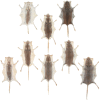Peromyscus mice as a model for studying natural variation
- PMID: 26083802
- PMCID: PMC4470249
- DOI: 10.7554/eLife.06813
Peromyscus mice as a model for studying natural variation
Abstract
The deer mouse (genus Peromyscus) is the most abundant mammal in North America, and it occupies almost every type of terrestrial habitat. It is not surprising therefore that the natural history of Peromyscus is among the best studied of any small mammal. For decades, the deer mouse has contributed to our understanding of population genetics, disease ecology, longevity, endocrinology and behavior. Over a century's worth of detailed descriptive studies of Peromyscus in the wild, coupled with emerging genetic and genomic techniques, have now positioned these mice as model organisms for the study of natural variation and adaptation. Recent work, combining field observations and laboratory experiments, has lead to exciting advances in a number of fields-from evolution and genetics, to physiology and neurobiology.
Keywords: Peromyscus; adaptation; ecology; evolution; mouse; natural history; the natural history of model organisms.
Conflict of interest statement
The authors declare that no competing interests exist.
Figures




References
-
- Allred DM. Plague important fleas and mammals in Utah and the western United States. The Great Basin Naturalist. 1952;12:67–75.
-
- Audubon JJ, Bachman J. The Quadrupeds of North America. Volume 3. New York: V. G. Audubon; 1854.
-
- Baird SF. Mammals of North America. Philadelphia: J. B. Lippincott & Co; 1859.
-
- Baker RH. Habitats and distribution. In: King JA, editor. Biology of Peromyscus (Rodentia) American Society of Mammalogists; 1968.
Publication types
MeSH terms
Grants and funding
LinkOut - more resources
Full Text Sources
Other Literature Sources
Molecular Biology Databases

